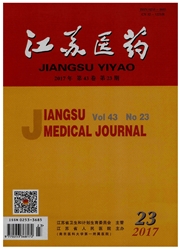

 中文摘要:
中文摘要:
目的探讨新生小鼠鼠巨细胞病毒(MCMV)性耳聋发病过程中血-迷路屏障通透性的改变及其可能机制。方法 66只新生BALB/C小鼠随机均分为三组:A组颅内注射MCMV 15μl;B组颅内注射生理盐水15μl;C组作为空白对照。3周后声电屏蔽下行听觉脑干反应(ABR)检查后取两侧耳蜗,伊文思蓝甲酰胺法检测血-迷路屏障通透性,光镜下观察内耳病理变化。结果与B、C组相比,A组小鼠ABRⅠ波潜伏期延长,波幅降低,听力阈值和耳蜗伊文思蓝含量升高(P〈0.05)。光镜下A组小鼠耳蜗前庭阶、鼓阶有出血现象,血管纹及螺旋韧带内有较多炎症细胞浸润;B、C组小鼠耳蜗无上述变化。结论新生小鼠颅内感染MCMV后,血-迷路屏障通透性增高是发生MCMV性耳聋的一个重要环节。
 英文摘要:
英文摘要:
Objective To investigate the change in the permeability of blood-labyrinth barrier (BLB) in neonatal mouse with murine cytomegalovirus(MCMV)-induced hearing loss and its possible mechanism. Methods Sixty-six neonatal BALB/C mice were equally and randomly divided into three groups of A(intracerebrally injected with MCMV 15 μl), B(intracerebrally injected with sterile normal saline 15 μ1) and C(blank control). Three weeks later, auditory evoked potential was used to detect murine auditory brain stem response (ABR) under electric shielding. The permeability of BLB was evaluated by measuring Evans blue(EB) content of the cochleas. The pathological changes of cochleas were observed by light microscope. Results Compared with groups of B and C, the latency period of wave I was prolonged,the wave amplitude was reduced, and the auditory threshold and EB content were increased in group A(P〈0. 05). Scala vestibule and scala tympani bleeding and infiltration of inflammatory cells in stria vascularis and spiral ligament were observed by light microscope in group A, while no obvious pathological changes were seen in groups of B and C. Conclusion The permeability of BLB is increased after MCMV intracranial infection in neonatal mouse, which might be a key point in MCMV-induced hearing loss.
 同期刊论文项目
同期刊论文项目
 同项目期刊论文
同项目期刊论文
 期刊信息
期刊信息
